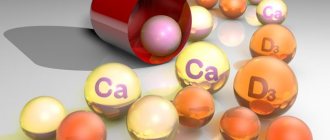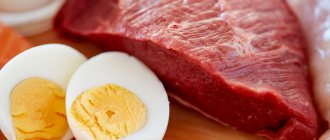Rational nutrition is the most important condition for maintaining health, normal growth and development of the human body. For normal functioning, the body requires a daily supply of not only basic nutrients (proteins, fats, carbohydrates) and water, but also many biologically active compounds - vitamins, microelements, minerals. An unbalanced diet, chronic stress, bad habits, concomitant diseases - all this can lead to a lack of vitamins, including B vitamins. Vitamins are not produced or are produced in insufficient quantities in the human body, which means they must be supplied with food. , in the required quantities. Insufficient intake of vitamins can occur under the influence of various factors - for example, diabetes, alcohol abuse, since alcohol reduces the absorption of vitamin substances in the gastrointestinal tract, various diseases of the digestive system, in which the absorption of nutrients is impaired.
How to determine vitamin B deficiency?
In recent years, there has been a lack of vitamins in a significant part of the population. In particular, deficiency of B vitamins is detected in 30-40% of subjects. Moreover, the deficiency is detected not only in winter and spring, but also in the summer-autumn period1. To establish an accurate diagnosis and determine the degree of vitamin deficiency, it is necessary to conduct a laboratory analysis: a comprehensive chromatographic study of venous blood. However, you can suspect a lack of vitamins in the body on your own. Clinical manifestations of B vitamin deficiency are nonspecific (drowsiness, indigestion, headaches, general weakness, sleep disturbance, dry skin, etc.), and may be signs of other diseases. Now we would like to focus on 2 of the 8 B vitamins: B1 (thiamine) and B6 (pyridoxine). These vitamins are directly involved in metabolic energy processes, hematopoiesis and the functioning of the nervous system2.
Vitamin B. Hypovitaminosis
B vitamins
Of course, this is nothing more than a tribute to historical tradition - calling vitamin B like that, in the singular. In fact, vitamin B is one, so to speak, in many faces. This group of substances contains twenty compounds, generalized by more or less similar (but not at all identical) properties. One of the most important such properties is water solubility ;
Unlike fat-soluble groups of vitamins, say, or, B vitamins dissolve in water, which significantly changes the mechanisms of their accumulation and absorption. In recent years, many reliable scientific facts have been obtained regarding vitamins, which have significantly deepened and expanded our understanding of these amazing substances. In particular, new terms had to be introduced, such as “provitamins” or “vitamin-like substances”. In addition, it turned out that not all B vitamins come only from the outside; some are synthesized by the body and therefore do not fall under the definitions of a “nutrient” or “vitamin.” Finally, ideas about the biological role and functions of vitamins, including group B, as well as possible chemical “avatars” of these compounds are constantly being refined and supplemented (thiamine alone can be represented in at least four forms). Research in this area has been going on for more than a hundred years: B vitamins were discovered, studied, and some of them were synthesized by the legendary biochemist Casimir Funk ( 1911 ), one of the fathers of vitaminology and the author of the very term “vitamin” ( 1912 ).
As far as is currently known, eight B vitamins are of greatest biological importance.
Vitamin B1 , thiamine, ensures the processes of growth, development, metabolism, and the functioning of a number of systems (nervous, cardiovascular, digestive, immune). It enters the body mainly with products from cereals and legumes; it is also found in beef and meat by-products, milk, and yeast.
Vitamin B2 , - riboflavin, lactoflavin, - is involved in fermentation, reproduction of red blood cells and immune factors, regulation of reproductive functions, binding of free radicals, ensuring the health of hair, nails, skin, retina (protection from ultraviolet radiation) and a number of other organs. Contained in nut and legume products, greens, liver and kidneys, mushrooms, etc.
Vitamin B3 - vitamin PP, niacin, nicotinic acid - is necessary for complete energy metabolism, synthesis of proteins and high-density lipoproteins (HDL, the so-called “good cholesterol”), microcirculation and regulation of vascular tone. Contained in nuts, poultry, fish, and a number of plant products.
Vitamin B5 , pantothenic acid, is involved in fermentation, metabolism, regulation of lipid production; stimulates regeneration processes (especially mucous membranes), intestinal peristalsis, synthesis of glucocorticosteroid hormones, immune factors, neurotransmitters. Contained in the most common foods of plant and animal origin, and also produced by E. coli.
Vitamin B6 , adermin, is present in the body in the form of pyridoxine, pyridoxidamine, pyridoxal and their compounds with phosphorus, and is necessary for the metabolism of amino acids and macroelements, stimulation of neurotrophism, secretion of a number of important neurotransmitters and hormones, hemoglobin, fats. Contained in plant tubers and sprouts, cereals, many fruits, seafood, meat, eggs, etc. May be partially replenished by the intestinal microbiome.
Vitamin B7 - biotin, vitamin H, coenzyme (coenzyme) R, “beauty vitamin” - is involved in carbohydrate metabolism, enzymatic processes, collagen secretion, maintaining healthy skin, hair and nails, regulating glucose levels, pregnancy and fetal development. Found in sprouted wheat and grain products, egg yolks, dairy products, red fish, nuts, etc.; In general, a regular balanced diet combined with a normally functioning intestine is sufficient to obtain the required concentrations of biotin.
Vitamin B9 , - folic acid, vitamin BC, vitamin M, a subgroup of folates, - is necessary for cell reproduction, erythropoiesis, effective metabolism, regulation of higher mental functions; is very important for the proper formation of the fetus during pregnancy by a woman. Contained in greens, citrus fruits, honey, “rough” varieties of bread, yeast, liver, etc. Like other B vitamins, it is partly supplied to the body by the intestinal microbiome.
Vitamin B12 , – Castle factor, a group of chemically complex organic compounds of cobalt (methylcobalamin, cyanocobalamin, hydroxocobalamin, etc.), – hematopoiesis, regulation and protection of the nervous system. Contained in meat, dairy and seafood. In addition, biologically significant quasi-vitamins B include choline, inositol, uracilcarboxylic acid, laetral, etc.
IN 1
Lack of B1 leads to energy deficiency, since the process of metabolism (metabolism) of carbohydrates is disrupted. As a result, the synthesis of fat-soluble acids, some hormones and amino acids is disrupted. One of the most well-known problems caused by chronic B1 deficiency is beriberi disease, which is common in countries where refined rice is the staple food. A large risk group is people with diabetes, since thiamine deficiency can lead to complications such as the development of polyneuropathy. Polyneuropathy is one of the most severe neurological disorders, which is characterized by multiple lesions of peripheral nerves. In diabetes, an excess amount of glucose causes metabolic disorders with damage to nerves and blood vessels, including those supplying the nerves. The main symptoms of polyneuropathy are loss of sensation in the lower extremities (arms, feet), burning sensation and crawling sensations, instability when walking3.
Vitamin B1 deficiency
With thiamine deficiency, the conversion of carbohydrates into lipids slows down, the synthesis of steroids - sex hormones - decreases, and energy metabolism suffers. Inhibition of lipid synthesis is the cause of prostaglandin deficiency.
With a deficiency of vitamin B1, encephalopathy can also develop, a condition characterized by disruption of the central nervous system, namely the brain.
Consumption of sugar, alcohol and tobacco depletes vitamin B1 reserves, and salt destroys it.
If you feel a lack of vitamin B1, I recommend including the following dishes in your menu:
- hummus;
- pea soup;
- potato casserole.
| Service | Price | Price | Promotion Price |
| Appointment with a therapist | primary 1800 rub. | repeat 1500 rub. | |
| Neurologist appointment | primary 1800 rub. | repeat 1500 rub. | free after MRI of the spine |
| Orthopedist appointment | primary 1800 rub. | repeat 1500 rub. | free after MRI of the joint |
| Consultation with an acupuncturist | primary 1800 rub. | repeat 1500 rub. | free after MRI of the spine |
| Vertebrologist consultation | primary 2000 rub. | repeat 1800 rub. | |
| Consultation with a chiropractor/osteopath | primary 2500 rub. |
| Service | Price according to Price | Discount | Discount |
| Plasma therapy of the spine or joint | 1 session 4000 rub. free doctor's appointment | 3 sessions 10,500 rub. free doctor's appointment | 5 sessions 17,500 rub. free doctor's appointment |
| Classic acupuncture session | 1500 rub. | ||
| Complex acupuncture session | 2000 rub. | ||
| Manual osteopathy session | 2500 rub. | ||
| Manual therapy session | 2500 rub. | ||
| Autohemotherapy | 550 rub. | 5 sessions 2500 rub. | 10 sessions 5000 rub. |
| Novocaine therapeutic blockade | 1500 rub. | ||
| Therapeutic paravertebral blockade | 1500 rub. | ||
| The blockade is therapeutic and medicinal, complex (use of several drugs) | 2000 rub. | ||
| Therapeutic intra-articular blockade with diprospan | 2500 rub. | ||
| Joint puncture with removal of synovial fluid | 2500 rub. | ||
| Intra-articular injection of hyaluronic acid (without the cost of the drug) | 2000 rub. | ||
| Novocaine therapeutic blockade | 1500 rub. | ||
| Therapeutic paravertebral blockade | 1500 rub. | ||
| Therapeutic intra-articular blockade with diprospan | 2500 rub. | ||
| Joint puncture with removal of synovial fluid | 2500 rub. | ||
| Pharmacocupuncture session (drug at the discretion of the doctor) | 2500 rub. | ||
| Pharmacocupuncture session (without the cost of the drug) | 2100 rub. | ||
| Electrophoresis session (without the cost of the drug) | 400 rub. | ||
| Phonophoresis session / Ultrasound therapy procedure (UT) (without the cost of the drug) | 450 rub. | ||
| Magnetic therapy session | 350 rub. | ||
| SMT therapy session (Sinusoidal modulated currents) | 450 rub. | ||
| Vitamin therapy (10 injections) | 4000 rub. free doctor's appointment | 3000 rub. free doctor's appointment | 3000 rub. free doctor's appointment |
| Injections (Vitamins B12) | 800 rub. | 800 rub. | 800 rub. |
| Intravenous administration of drugs | 450 rub. | 5 sessions 2140 rub. | 10 sessions 4050 rub. |
| Intravenous drip administration of drugs (without drugs, 1 bottle) | 800 rub. | 5 sessions 3375 rub. | 10 sessions 6750 rub. |
| Intravenous drip administration of medications (with existing clinic medications, 1 bottle) | 950 rub. | 5 sessions 4050 rub. | 10 sessions 8100 rub. |
| Intravenous drip administration of drugs (without drugs, 2 bottles) | 950 rub. | 5 sessions 4050 rub. | 10 sessions 8100 rub. |
| Intravenous drip administration of medications (with existing clinic medications, 2 bottles) | 1100 rub. | 5 sessions 4700 rub. | 10 sessions 9400 rub. |
| Subcutaneous/intradermal administration of drugs | 250 rub. | 5 sessions 1180 rub. | 10 sessions 2250 rub. |
| Intramuscular administration of drugs | 300 rub. | 5 sessions 1430 rub. | 10 sessions 2700 rub. |
Author: Telegina Natalya Dmitrievna
Therapist with 25 years of experience
AT 6
Signs of vitamin B6 deficiency include a variety of symptoms, such as irritability/lethargy, decreased appetite/nausea, very dry skin (sicca) and others. These and other clinical signs of vitamin B6 deficiency begin to appear quite quickly, even possibly within a few weeks of deficient intake, or due to high consumption of vitamin B6. With B6 deficiency, the synthesis of hemoglobin and the absorption of iron from food deteriorate, the formation of antibodies decreases, and the processes of carbohydrate metabolism slow down. Due to a lack of vitamins, the following also develop:
- digestive problems - irritable bowel syndrome, stomatitis, seizures;
- skin problems - oily seborrhea of the A-zone, rashes on the wings of the nose, around the mouth and eyes;
- anemia;
- problems with the central nervous system - epileptic seizures, insomnia, emotionality, depression;
- polyneuropathy, mainly sensory.
In combination, vitamin B6 deficiency leads to serious problems with mental and motor activity, provokes the development of serious damage to the central nervous system, and complicates recovery after heart attacks, strokes and surgical interventions.










